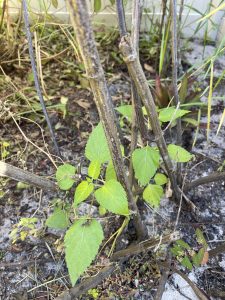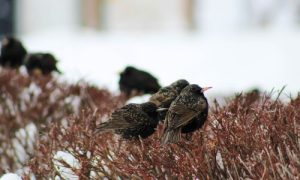 Dilemma: To Prune or Not To Prune in November!
Dilemma: To Prune or Not To Prune in November!
Are you tempted to cut or pull spent plants that have gone to seed? Isn’t a neatly trimmed bed delightfully satisfying and aren’t you dying to clean it all up after the chaos of this mad, hot summer?
Wait!
If you can.
Some are putting out new foliage at the base of the spent flowering stems. (salvia, for example) Others may be true herbaceous perennials that die back to their living root. Leave stem stumps to make their location. (dahlias, agapanthus, lilies, curcuma, etc.)
If you can, try leaving spent stems standing until spring.
 Birds will eat the seeds and some stems may have beneficial insects or their larvae, such as bees nesting in them. By allowing seeds to fall, the plant will self-seed. Which is always a cool surprise next year, to see what might want be where.
Birds will eat the seeds and some stems may have beneficial insects or their larvae, such as bees nesting in them. By allowing seeds to fall, the plant will self-seed. Which is always a cool surprise next year, to see what might want be where.
 Butterfly chrysalis can just look like a dead leaf on the stem. Not all butterfly chrysalis are distinctive looking like the monarch’s chrysalis.
Butterfly chrysalis can just look like a dead leaf on the stem. Not all butterfly chrysalis are distinctive looking like the monarch’s chrysalis.
Leave fallen leaves in your garden. They make great mulch and home for critters. Diseased leaves should be raked up and disposed of, so they won’t carry over an infection. If you need to neaten up a front yard, put the prunings in a loose pile in the rear yard. I use a tomato cage to corral them and call it a bird feeder!
Spring Blooming Plants
Don’t prune spring blooming plants as you’ll lose their bloom for the year. Do not touch them after July 4th. Azaleas, dogwood and redbud are some of the spring blooming plants. Hydrangeas can be spring bloomers or repeat bloomers, depending on the cultivar. Winter blooming plants, like Carolina jessamine (Gelsemium sempervirens) and camellias also shouldn’t be pruned now.
What You Can Prune – In The Real Winter
Winter is a good time to prune deciduous shrubs and trees, as you can see their form for proper pruning. Don’t prune evergreen shrubs and trees in fall and winter, as they may put out new tender growth that would be damaged by freezes.
Vines need to be pruned to control them. Deciduous Grape vine, Virginia creeper and other woody vine prunings can be used to make wreaths or baskets. Wait until spring to prune passion vine and keep a lookout for butterfly chrysalis.
Tropical plants may be frozen back, so wait until spring to prune freeze damage. Those dead stems and leaves help protect the crown.
Ornamental grasses shouldn’t be pruned before spring new growth starts.
Fall is a great time to garden. Plant a fall-winter vegetable garden. You can plant hardy trees and shrubs now and their roots will have time to get established before summer’s heat. It’s lovely cool weather for doing those big projects like landscape redesign.
Instead of Pruning in November, try these tasks:-
- Citrus: Protect small citrus trees if freezing temperatures are predicted by watering well at least a day before the freeze. You may also use covers that extend to the ground for protection. See Cold Protection and Chilling Damage of Landscape Plants: https://edis.ifas.ufl.edu/topic_landscapes_and_cold
- Scale insects: Apply dormant oil sprays to control scale insects on trees and shrubs. See Landscape Pest Management: https://edis.ifas.ufl.edu/topic_landscape_pests
- Irrigation: Turn off systems and water only if needed. Plants need less supplemental watering in cooler weather. See Landscape Irrigation: https://edis.ifas.ufl.edu/topic_landscape_irrigation
- Flowering trees: Consider planting an ornamental Taiwan cherry (Prunus campanulata). Late winter brings pink blooms. See The Florida-Friendly Landscaping™ Guide to Plant Selection and Landscape Design: https://ffl.ifas.ufl.edu/homeowners/publications.htm
- Birds: Make a small brush pile from plant debris in the back of the yard for birds. See Wild Birds: https://edis.ifas.ufl.edu/topic_wild_birds
- Camellias: Add some of the new cultivars for bright spots of color in winter. Disbudding, or removing some buds now, ensures larger blooms later. See Camellias: https://edis.ifas.ufl.edu/topic_camellia
—-This article was written by MGV Brenda Daly and is the second half of an article that appeared in the Times Union during October 2023.
Source: UF/IFAS Pest Alert
Note: All images and contents are the property of UF/IFAS.



